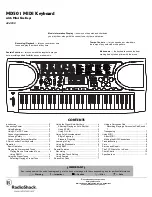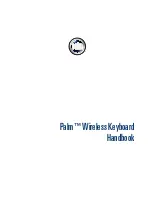
Effects
Distortion
9-19
Trigger
is
the
input
‐
signal
threshold
at
which
the
envelope
detector
triggers.
Range
is
‐
79
to
0
dB.
Retrigger
is
the
input
‐
signal
threshold
at
which
the
envelope
detector
resets,
so
that
it
can
trigger
again.
This
parameter
is
only
useful
when
it
is
set
below
the
value
of
Trigger.
Range
is
from
‐
79
to
0
dB.
Env
Rate
is
the
envelope
detector
decay
rate.
This
can
be
used
to
prevent
false
triggering.
When
the
signal
envelope
falls
below
the
retrigger
level,
the
filter
can
be
triggered
again
when
the
signal
rises
above
the
trigger
level.
Since
the
input
signal
can
fluctuate
rapidly,
it
is
necessary
to
adjust
the
rate
at
which
the
signal
envelope
can
fall
to
the
retrigger
level.
The
range
is
0
to
300.0
dB/sec.
Rel
Rate
is
the
downward
slew
(release)
rate
of
the
triggered
envelope
generator.
The
range
is
0
to
300.0
dB/sec.
Smth
Rate
slows
down
the
envelope
follower.
If
set
lower
than
the
release
rate,
it
will
dominate
it.
You
can
also
use
the
smoothing
rate
to
lengthen
the
attack
of
the
internal
envelope.
The
range
is
0
to
300.0
dB/sec.
LFO Filter
The
LFO
filter
is
continuously
swept
between
two
resonant
frequencies
over
a
period
of
time.
The
LFO
frequency,
expressed
in
BPM
and
beats,
can
be
fixed
or
set
to
follow
System
tempo.
(See
Chapter
4
for
information
about
tempo
control
of
PC3K
parameters.)
Min
Freq
and
Max
Freq
are
the
low
and
high
limits
of
the
resonant
frequency
as
the
filter
is
swept.
You
can
set
the
Min
Freq
higher
than
the
Max
Freq,
in
which
case
the
filter
will
sweep
“upside
down”
relative
to
the
controlling
clock.
The
range
for
both
is
16
to
8372
Hz.
LFO
Shape
is
the
waveform
type
for
the
LFO.
Choices
are
Sine,
Saw+,
Saw
‐
,
Pulse,
and
Tri.
LFO
PlsWid
(Pulse
Width).
When
the
LFO
Shape
is
set
to
Pulse,
this
sets
the
pulse
width
as
a
percentage
of
the
waveform
period.
When
the
width
is
set
to
50%,
the
result
is
a
square
wave.
This
parameter
has
no
effect
if
other
waveform
types
are
chosen.
Range
is
0
to
100%.
LFO
Smooth
smooths
(removes
the
higher
harmonics
from)
the
Saw+,
Saw
‐
,
and
Pulse
waveforms.
A
Sawtooth
wave
becomes
more
like
a
triangle
wave,
and
a
Pulse
wave
becomes
more
like
a
sine
wave.
Range
is
0
to
100%.
Distortion
Distortion
algorithms
on
the
PC3K
may
also
include
a
parametric
equalizer
or
a
cabinet
simulator.
Dist
Drive
applies
a
boost
to
the
input
signal
to
overdrive
the
distortion
algorithm
into
soft
clipping.
This
will
tend
to
make
the
signal
very
loud,
so
you
may
have
to
reduce
the
Out
Gain
as
this
parameter
is
increased.
Range
is
0
to
96
dB.
Warmth
is
a
lowpass
filter
in
the
distortion
control
path.
This
filter
may
be
used
to
reduce
some
of
the
harshness
of
some
distortion
settings
without
reducing
the
bandwidth
of
the
signal.
Range
is
16
to
25088
Hz.
Highpass
allows
you
to
reduce
the
bass
content
of
the
distortion
content
in
the
smaller
distortion
algorithms
that
don’t
have
true
parametric
EQ.
Range
is
16
to
25088
Hz.
Cab
Preset
selects
from
eight
cabinet
simulations
which
have
been
created
based
on
measurements
of
real
guitar
amplifier
cabinets.
The
presets
are:
Basic,
Lead
12,
2x12,
Open
12,
Open
10,
4x12,
Hot
2x12,
and
Hot
12.
Summary of Contents for PC3K6
Page 24: ...1 6 Introduction Options...
Page 50: ...4 4 The Operating Modes Using the Modes...
Page 58: ...5 8 Editing Conventions Special Button Functions...
Page 130: ...6 72 Program Mode Programming Tips...
Page 202: ...7 72 Setup Mode Recording A Setup To Song Mode...
Page 206: ...8 4 Quick Access Mode The QA Editor...
Page 232: ...9 26 Effects Mono Algorithms...
Page 268: ...11 18 Master Mode Preview Sample PRVIEW...
Page 302: ...12 34 Song Mode and the Song Editor Song Editor The EVENT Page...
Page 328: ...14 14 Keymap and Sample Editing Editing Samples...
Page 334: ...B 4...
Page 370: ...D 32 PC3K Objects V 1 31 Effect Chains...
Page 372: ...E 2 PC3K Legacy File Conversion Object Types and Conversion Details...
















































